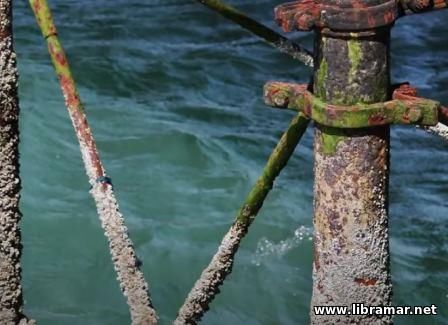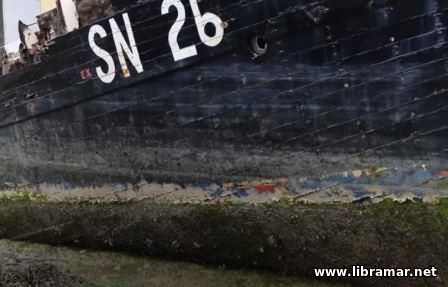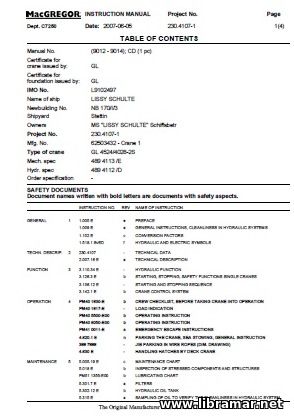Why Are Ships Painted Red Below the Waterline?

Have you noticed how boats, both large and small, tend to be painted a different color under the water? Most often, it is red but actually nowadays you can get any color you like. The reason for it goes back to the earliest days of sailing ships. Back in those days wooden sailing ships would slowly plot around the world. A combination of their slow speed and rough hull made them an ideal breeding ground for underwater growth. Just take a look under a pier and you will see the sort of marine growth these ships used to suffer. We are talking barnacles, worms, seaweed, and things like that, so that is the issue.
Well, all of these things have negative impacts on ships over time. You get the obvious of things like damage to the hull itself due to worms and the actual growth; then you get issues like the additional weight that they have to carry around and reduction in maximum speed due to the extra drag. Of course, on sailing vessels that drag-on weight would impact their ability to sail upwind which would yet further reduce their efficiency. What you need is a way to stop marine life from growing on the bottom of the hull and this is where antifouling comes in.
this is where antifouling comes in.
Antifouling is just a system designed to reduce fouling by animal and plant life on the underwater sections of a boat or a ship. Early solutions were to place copper sheets on the hulls of ships. The “Cutty Sark” is a great example of this. The primary purpose of the copper sheets was actually to stop worms eating their way through wooden hulls. A secondary benefit is that the copper would reduce the growth of plant life.
Of course, as wooden hulls were replaced by iron, worm issue did reduce but they have never been eliminated. Just look at the leisure industry today and you will still see a plenty of wooden hulls around, and of course regardless of its construction materials we still have the same old issue of drag caused by the growth of plant life is probably more important now to keep that under control, considering the costs of fuel and efficiency savings on long passages.
We still need antifouling to stop a combination of worms, barnacles and weed from growing on the underside of the hulls but instead of using the old technique of copper sheets we now use a form of paint. The subject paint works on the same principle and actually still uses copper as a biocide though it is mostly cuprous oxide mixed with the paint rather than copper sheets.
It is the natural red color of those copper oxides that has led to the traditional red color of antifouling. Modern antifouling systems can be broken into two broad categories – hard and soft. Soft coatings are designed to wear off over time continuously exposing  fresh biocides as the outer layer of the paint wears off. Hard coatings, on the other hand, are designed to be lot more durable. They are meant to last a lot longer. As the biocides are released the durable layer of paint remains but the biocides contained in the outermost layer do get used up.
fresh biocides as the outer layer of the paint wears off. Hard coatings, on the other hand, are designed to be lot more durable. They are meant to last a lot longer. As the biocides are released the durable layer of paint remains but the biocides contained in the outermost layer do get used up.
Both systems work on the same principle. They gradually release biocides commonly based on the chemical element copper. The difference is that the soft coatings allow the paint to flake off as well. As you can imagine, there are environmental considerations – antifouling releases biocides and possibly paint into the environment. That is one reason a lot of ports do not allow cleaning the hulls. They do not want the extra dose of biocides and paint released by the rubbing process.
One of the other options is to use the normal hardware and paint on the other side of the hull but that will result in a lot of aquatic growth. That is fine on a small boat that you can pull out of the water and clean quite often, but is not so great on a container ship running around the world. What would happen if, for example, container ship picked some weed in Asia and carried it into the Baltic Sea where it takes hold and overtakes some of the native species? Similar things have happened and do actually continue to happen though it is not so much from hull growth because antifouling is more of an issue for the ballast water.
So, aside from just using no antifouling, what could you do? There is a talk of systems that slowly use some sort of jelly from the hull. The theory is that as the growth attaches to the hull, the jelly seeps off and takes the growth with it. There are also some silicon based paints that make it hard for barnacles to stick to the hull. Unfortunately, these do not actually stop the growth but it makes it easier to clean off.
As said above, most ports do not allow cleaning anyway not only because of the historical antifouling issues but also they do not want to clean off species that are not native to the harbor itself. The last thing they want is to be overcome by some sort of invasive weed from the other side of the world.
The "Read Later" function allows you to add material to this block with just one click. Just click on the icon and read the articles that interest you at any convenient time.


